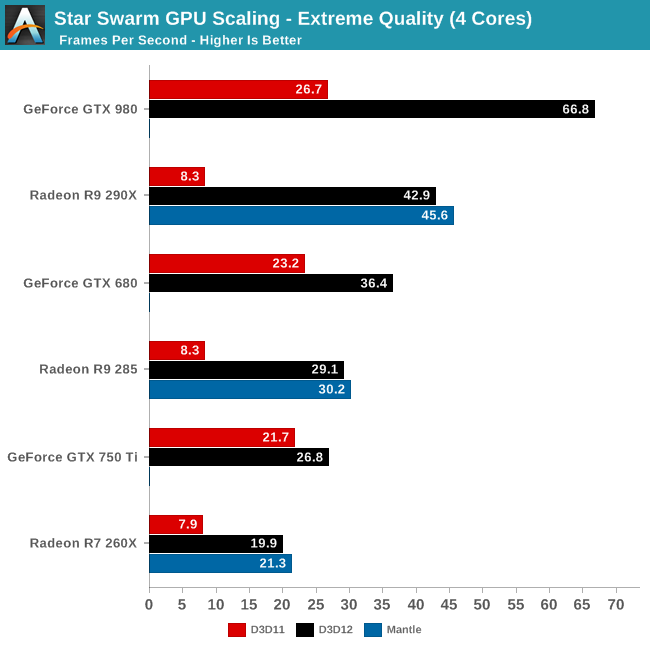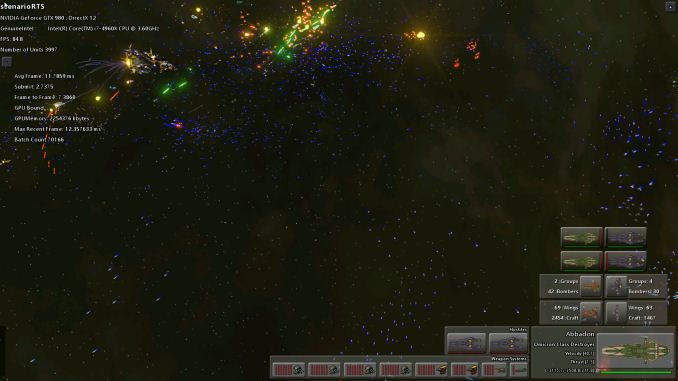The DirectX 12 Performance Preview: AMD, NVIDIA, & Star Swarm
by Ryan Smith on February 6, 2015 2:00 PM EST- Posted in
- GPUs
- AMD
- Microsoft
- NVIDIA
- DirectX 12
Star Swarm & The Test
For today’s DirectX 12 preview, Microsoft and Oxide Games have supplied us with a newer version of Oxide’s Star Swarm demo. Originally released in early 2014 as a demonstration of Oxide’s Nitrous engine and the capabilities of Mantle, Star Swarm is a massive space combat demo that is designed to push the limits of high-level APIs and demonstrate the performance advantages of low-level APIs. Due to its use of thousands of units and other effects that generate a high number of draw calls, Star Swarm can push over 100K draw calls, a massive workload that causes high-level APIs to simply crumple.
Because Star Swarm generates so many draw calls, it is essentially a best-case scenario test for low-level APIs, exploiting the fact that high-level APIs can’t effectively spread out the draw call workload over several CPU threads. As a result the performance gains from DirectX 12 in Star Swarm are going to be much greater than most (if not all) video games, but none the less it’s an effective tool to demonstrate the performance capabilities of DirectX 12 and to showcase how it is capable of better distributing work over multiple CPU threads.
It should be noted that while Star Swarm itself is a synthetic benchmark, the underlying Nitrous engine is relevant and is being used in multiple upcoming games. Stardock is using the Nitrous engine for their forthcoming Star Control game, and Oxide is using the engine for their own game, set to be announced at GDC 2015. So although Star Swarm is still a best case scenario, many of its lessons will be applicable to these future games.
As for the benchmark itself, we should also note that Star Swarm is a non-deterministic simulation. The benchmark is based on having two AI fleets fight each other, and as a result the outcome can differ from run to run. The good news is that although it’s not a deterministic benchmark, the benchmark’s RTS mode is reliable enough to keep the run-to-run variation low enough to produce reasonably consistent results. Among individual runs we’ll still see some fluctuations, while the benchmark will reliably demonstrate larger performance trends.
The Test
For today’s preview Microsoft, NVIDIA, and AMD have provided us with the necessary WDDM 2.0 drivers to enable DirectX 12 under Windows 10. The NVIDIA driver is 349.56 and the AMD driver is 15.200. At this time we do not know when these early WDDM 2.0 drivers will be released to the public, though we would be surprised not to see them released by the time of GDC in early March.
In terms of bugs and other known issues, Microsoft has informed us that there are some known memory and performance regressions in the current WDDM 2.0 path that have since been fixed in interim builds of Windows. In particular the WDDM 2.0 path may see slightly lower performance than the WDDM 1.3 path for older drivers, and there is an issue with memory exhaustion. For this reason Microsoft has suggested that a 3GB card is required to use the Star Swarm DirectX 12 binary, although in our tests we have been able to run it on 2GB cards seemingly without issue. Meanwhile DirectX 11 deferred context support is currently broken in the combination of Star Swarm and NVIDIA's drivers, causing Star Swarm to immediately crash, so these results are with D3D 11 deferred contexts disabled.
For today’s article we are looking at a small range of cards from both AMD and NVIDIA to showcase both performance and compatibility. For NVIDIA we are looking at the GTX 980 (Maxwell 2), GTX 750 Ti (Maxwell 1), and GTX 680 (Kepler). For AMD we are looking at the R9 290X (GCN 1.1), R9 285 (GCN 1.2), and R9 260X (GCN 1.1). As we mentioned earlier support for Fermi and GCN 1.0 cards will be forthcoming in future drivers.
Meanwhile on the CPU front, to showcase the performance scaling of Direct3D we are running the bulk of our tests on our GPU testbed with 3 different settings to roughly emulate high-end Core i7 (6 cores), i5 (4 cores), and i3 (2 cores) processors. Unfortunately we cannot control for our 4960X’s L3 cache size, however that should not be a significant factor in these benchmarks.
| DirectX 12 Preview CPU Configurations (i7-4960X) | |||
| Configuration | Emulating | ||
| 6C/12T @ 4.2GHz | Overclocked Core i7 | ||
| 4C/4T @ 3.8GHz | Core i5-4670K | ||
| 2C/4T @ 3.8GHz | Core i3-4370 | ||
Though not included in this preview, AMD’s recent APUs should slot between the 2 and 4 core options thanks to the design of AMD’s CPU modules.
| CPU: | Intel Core i7-4960X @ 4.2GHz |
| Motherboard: | ASRock Fatal1ty X79 Professional |
| Power Supply: | Corsair AX1200i |
| Hard Disk: | Samsung SSD 840 EVO (750GB) |
| Memory: | G.Skill RipjawZ DDR3-1866 4 x 8GB (9-10-9-26) |
| Case: | NZXT Phantom 630 Windowed Edition |
| Monitor: | Asus PQ321 |
| Video Cards: | AMD Radeon R9 290X AMD Radeon R9 285 AMD Radeon R7 260X NVIDIA GeForce GTX 980 NVIDIA GeForce GTX 750 Ti NVIDIA GeForce GTX 680 |
| Video Drivers: | NVIDIA Release 349.56 Beta AMD Catalyst 15.200 Beta |
| OS: | Windows 10 Technical Preview 2 (Build 9926) |
Finally, while we’re going to take a systematic look at DirectX 12 from both a CPU standpoint and a GPU standpoint, we may as well answer the first question on everyone’s mind: does DirectX 12 work as advertised? The short answer: a resounding yes.












245 Comments
View All Comments
junky77 - Friday, February 6, 2015 - link
Looking at the CPU scaling graphs and CPU/GPU usage, it doesn't look like the situation in other games where CPU can be maxed out. It does seem like this engine and test might be really tailored for this specific case of DX12 and Mantle in a specific wayThe interesting thing is to understand whether the DX11 performance shown here is optimal. The CPU usage is way below max, even for the one core supposedly taking all the load. Something is bottlenecking the performance and it's not the number of cores, threads or clocks.
eRacer1 - Friday, February 6, 2015 - link
So the GTX 980 is using less power than the 290X while performing ~50% better, and somehow NVIDIA is the one with the problem here? The data is clear. The GTX 980 has a massive DX12 (and DX11) performance lead and performance/watt lead over 290X.The_Countess666 - Thursday, February 19, 2015 - link
it also costs twice as much.and this is the first time in roughly 4 generations that nvidia's managed to release a new generation first. it would be shocking is there wasn't a huge performance difference between AMD and nvidia at the moment.
bebimbap - Friday, February 6, 2015 - link
TDP and power consumption are not the same thing, but are relatedif i had to write a simple equation it would be something to the effect of
TDP(wasted heat) = (Power Consumption) X (process node coeff) X (temperature of silicon coeff) X (Architecture coeff)
so basically TDP or "wasted heat" is related to power consumption but not the same thing
Since they are on the same process node by the same foundry, the difference in TDP vs power consumed would be because of Nvidia currently has the more efficient architecture, and that also leads to their chips being cooler, both of which lead to less "wasted heat"
A perfect conductor would have 0 TDP and infinite power consumption.
Mr Perfect - Saturday, February 7, 2015 - link
Erm, I don't think you've got the right term there with TDP. TDP is not defined as "wasted heat", but as the typical power draw of the board. So if TDP for the GTX 980 is 165 watts, that just means that in normal gaming use it's drawing 165 watts.Besides, if a card is drawing 165watts, it's all going to become heat somewhere along the line. I'm not sure you can really decide how many of those watts are "wasted" and how many are actually doing "work".
Wwhat - Saturday, February 7, 2015 - link
No, he's right TDP means Thermal design power and defines the cooling a system needs to run at full power.Strunf - Saturday, February 7, 2015 - link
It's the same... if a GC draws 165W it needs a 165W cooler... do you see anything moving on your card exept the fans? no, so all power will be transformed into heat.wetwareinterface - Saturday, February 7, 2015 - link
no it's not the same. 165w tdp means the cooler has to dump 165w worth of heat.165w power draw means the card needs to have 165w of power available to it.
if the card draws 300w of power and has 200w of heat output that means the card is dumping 200w of that 300w into the cooler.
Strunf - Sunday, February 8, 2015 - link
It's impossible for the card to draw 300W and only output 200W of heat... unless of course now GC defy the laws of physics.grogi - Sunday, April 5, 2015 - link
What is it doing with the remaining 100W?